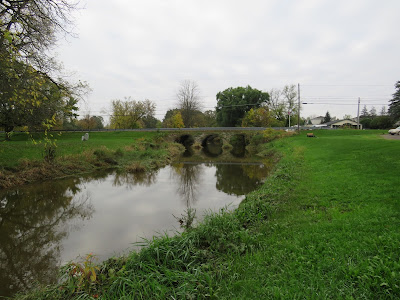Riley and I are hiking along the edge of the Little Salt River (Salt Creek) in Isabella County’s village of Shepherd. Under overcast skies, the morning air is calm with mild temperatures as I look around to notice several, tall Northern Catalpa trees with their very large, heart-shaped leaves, marked with many small holes. Most likely these holes are made by larvae of the Sphinx Moth (stock photo) feeding on them, which is their only food source. This tree is sometimes called the Indian bean tree for its production of a distinctive fruit that resembles a long, thin bean pod that can grow up to two feet in length. Climbing down to explore the flood plain, I spot a variety of broadleaves changing color including: Virginia Creeper, Poison Ivy, Raspberry and American Elm. In addition, a variety of fruit catch my attention, including: Wild Grape, Viburnum and Multiflora Rose. At the river’s edge, I pause to observe the rapidly flowing water head northeasterly on its 15-mile journey where it will converge with the Chippewa River in Midland County. Given the unusually warm and rainy weather recently, I’m not surprised to observe fresh mushrooms, including: non-edible, White Cheese Polypore and non-edible, Cinnabar Polypore. Plodding our way through a pathless landscape, I come upon two types of Goldenrod galls, a nut gall and a bunch gall. Overhead, I notice a perching White-throated Sparrow. Most of this species migrate from here to spend the winter in the eastern United States, ranging from New England to way down in Florida. Nearby, I spot a perching Yellow-rump Warbler, another bird that will soon be heading south for the winter. On our way back to the car, I locate a patch of Wild Carrot plants with their seed heads tightly folded up. Sometimes these tiny “nests” provide food and shelter for larva such as the Carrot Seed Moth caterpillar (stock photo). Lastly, I bend down to open a walnut husk, lying on the ground, to see larvae of the Walnut Husk Fly feeding on the fleshy layer. These maggots will soon crawl into the soil and overwinter as pupae. Adult flies (stock photo) will start to emerge early next summer and continue through October. Finally, female flies will lay eggs under the skin of walnuts that will hatch into larvae as the cycle repeats.
Maples take their places
Nature sets the stage
Forest curtain opens
Autumn comes of age
Colorful leaves illuminated
By early morning sun
Blanket a barren ground
End of scene one
Canopy has thinned
Revealing sky of blue
Geese in V formation
End of scene two
D. DeGraaf

No comments:
Post a Comment